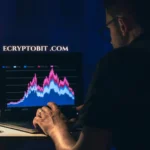You load the page. Blank. No menu. No login. Not even a 404. Just digital snow, static where your brokerage should be. Your mouse twitches like it’s trying to find a pulse. Refresh. Nothing. Try incognito. Still nothing. Maybe it’s a hiccup on Blank website. Maybe it’s doom.
In the slippery world of online trading, a completely blank website isn’t just an inconvenience. It can be the first sign that something’s very wrong. Traders know outages happen, sure, but this? This is different. When the site vanishes entirely, leaving no breadcrumbs, it’s time to ask hard questions. Is it a technical hiccup, or a signal flare warning you of a regulatory freeze, a server meltdown, or worse—a company that packed up overnight with your money in its back pocket?
And it matters even more if you’ve been tracking volatile assets like Bitcoin and watching the current Bitcoin price, waiting to move. A frozen platform at the wrong moment could cost you gains, or worse, lock you out before a drop. It’s not just frustrating. It’s risk in its purest, rawest form.
Regulatory and Security Risks Behind Suddenly Unavailable Broker Sites
Let’s spell it out: financial platforms don’t just disappear. Not without reason. Sometimes it’s a DDoS attack—the digital equivalent of rioters slamming the front door until the servers buckle. Other times it’s internal. A company folding. Or regulators stepping in with a freeze order. No trades. No withdrawals. No nothing.
There are signals if you know where to look. A platform might vanish from search results. Email communications go dark. Social channels quieten, or disappear entirely. These aren’t just quirks of bad marketing. These are escape routes being sealed behind you.
The Financial Conduct Authority in the UK and similar regulators globally often post updates on firms under investigation or suspended at Blank website. But those posts are usually written in cold legalese. You won’t find drama there, but you will find truth. Always check. Don’t wait for a full-page apology or a newsflash. By then, it’s too late.
How Users Can Verify a Platform’s Status and Legitimacy
Now comes the detective work. Start with the regulator’s site. It’s not beautiful. But it’s real. Search the name. If they’re in trouble, it’s often there.
Next, search the news. Be precise. Use the platform’s name plus “outage,” “frozen account,” or “regulatory action.” If there’s fire, you’ll smell the smoke in the headlines. If nothing comes up, it might mean you’re the canary in the coal mine.
Then: go where the noise is. Forums. Discord. Reddit. These corners of the internet don’t wear ties, but they know things. Traders live there. Panic shows up early and often. If dozens are shouting about a Blank website or blank screen, it’s not just you.
Try accessing the site from another device or a different connection. The mobile app. Your friend’s laptop. Maybe even the cached version on Google. One glimpse of a login screen can tell you it’s a regional problem. If it all comes up empty, it could be bigger.
Still calm? Reach for customer support. Their response—or lack of it—will tell you what you need to know. Reputable platforms have status pages, or at least a tweet or two explaining downtime. Silence? That’s a red flag all on its own.
And if you can still access your balance via third-party aggregator tools or synced apps, check it. Is your portfolio intact? Are the numbers right? Or is it just more Blank website space? That data’s your lifeline. When it’s gone, you don’t have to guess anymore. The fire alarm is ringing.
The smartest traders always keep a backup brokerage ready. Don’t wait until things fall apart to look for a plan B. Have it verified. Keep it in your pocket. That’s not paranoia. That’s insurance.
So to recap:
- Check official financial regulators for warnings or suspensions
- Search news headlines with specific keywords related to outages or breaches
- Scan social and trading forums for real-time chatter
- Test different devices and cached versions for access
- Contact customer support (and note how long it takes to hear back)
- Review your balances via apps or aggregators
- Always keep a second trading account ready to deploy
Expand your knowledge with this handpicked companion read.
Ways to Access Information During Outages
When your brokerage goes dark, don’t just sit there watching your screen like Jack waiting for Rose to come back on the raft. Move. Your information sources need to be broad. Don’t rely on just one channel.
Use aggregator sites to track market prices in real time. Look at Twitter for breaking news—the signal-to-noise ratio might be terrible, but speed is on your side. Bookmark third-party financial news outlets. Set alerts. Know which influencers in your asset space are trustworthy. Use RSS feeds if you must. Go old-school, if it works.
And connect with the community. If you’re trading crypto, DeFi, or even equities, there’s a Telegram group or Reddit thread out there full of people experiencing the same outage. Those voices matter. The trading community becomes your barometer in times of fog.
A Final Word on Staying Sharp
Trading is business, but it’s also survival. Technology made it faster and prettier. But it also made it riskier. And when everything vanishes behind a blank white screen, you need to think like a detective and move like a chess player. Quiet. Deliberate.
Think of “Mr. Robot.” When Elliot sees a screen go dark, he doesn’t assume a power outage. He starts tracing the breach, asking: who benefits? You should too.
If your screen goes blank, don’t assume it’s just a bug. Ask what it’s hiding. Look for footprints. Find the fire exit.
The future of trading is digital, no question. But its dangers are very real. Stay curious. Stay suspicious. And never assume a blank page or Blank website means nothing.
Because sometimes, that silence? It’s screaming.
Want more insights like this? Head over to 2A Magazine and start exploring.







